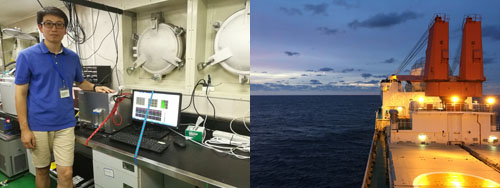The Arctic is observed warming faster than other regions of the Earth, and the reduction in sea-ice extent exceeds natural variability. Atmospheric aerosols—natural or anthropogenic particles— suspending over polar region attract great attention for its pivotal effects on climate change.
"The Arctic climate is particularly influenced by anthropogenic aerosols and is sensitive to the composition and optical properties of these aerosols." PAN Xiaole, a scientist from Institute of Atmospheric Physics at Chinese Academy of Sciences, explained, "Changes in atmospheric loading and mixing state of aerosols significantly influence the radiation balance and cloud process of the climate system.”
That’s why Pan and his team set out to study the mixing state and morphology properties of aerosol particles over the northwest Pacific Ocean and Arctic Ocean on board the R/V Xuelong---a Chinese icebreaker---to remote polar marine region.

PAN Xiaole and his optical particle counter on board Xuelong, Chinese icebreaker (Image by PAN Xiaole)
"Traditionally, we use ship-borne and satellite-borne LIDAR to observe depolarization characteristics and transport structure of Arctic aerosols." Said PAN. "This time, we observed variation of every single particles using a newly developed optical particle counter equipped with a polarization detection module." The instrument is capable of detecting size-resolved depolarization properties of ambient particles.
Pan obtained a dataset of single particle depolarization ratio of sea-level aerosols and found that the sea salt aerosols in the polar region had a more irregular shape than that in near-shore region in Northwest Pacific because of dry air conditions.
"On the basis of synoptic pattern analysis and back trajectory analysis, we conclude that pollution over the Arctic Ocean is from marine emission of sea salt particles influenced by oceanic cyclone system." Said PAN, "while in northwest Pacific region, long-range transport pollutants from the continent were among the primary causes."
The dataset is published in Environ Sci Technol, and is the first to document the polarization properties of single particles over Polar Region, providing a valuable dataset for evaluating LIDAR measurement. Moreover, it provides a deeper understanding of the mixing characteristics and mechanisms of morphological change of aerosol in Arctic.
Reference: Tian, Y., Pan, X., Yan, J., Lin, Q., Sun, Y., Li, M., Xie, C., Uno, I., Liu, H., Wang, Z., Fu, P., and Wang, Z.: Size Distribution and Depolarization Properties of Aerosol Particles over the Northwest Pacific and Arctic Ocean from Shipborne Measurements during an R/V Xuelong Cruise, Environ Sci Technol, 53, 7984-7995, 10.1021/acs.est.9b00245, 2019.
Media Contact: Ms. LIN Zheng, jennylin@mail.iap.ac.cn
